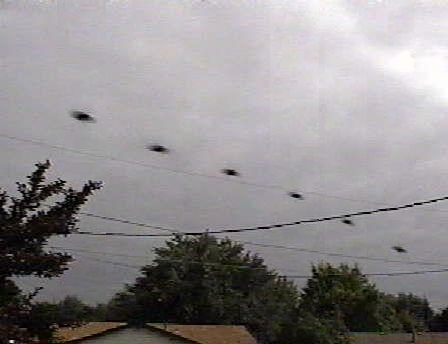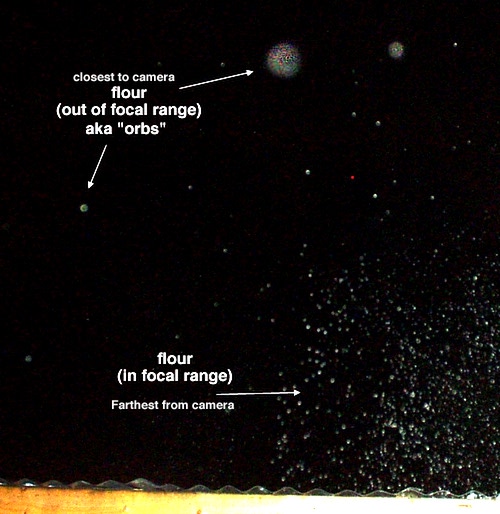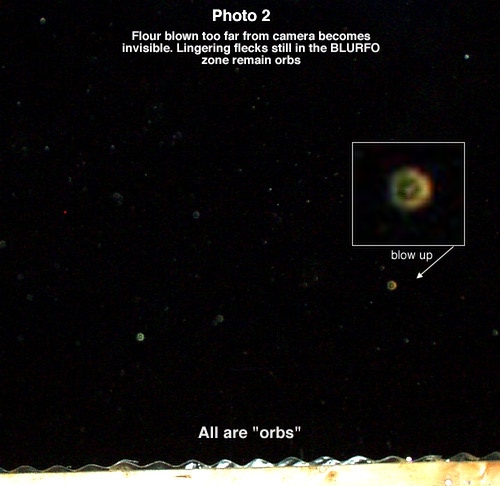- Comment on Orbs
From Bruce Maccabbe
2-20-4
Saw the recent article by Neff on BLURFOs and orbs. You might consider
adding the following link to my research on "flash orbs". I have
recently received emails from people claiming that such orbs are creatures
from another dimension, etc. They claim to see faces in the orbs.
-
- Anyway, I have provided a lot of scientific data on flash
orbs that support's Neff's work. http://brumac.8k.com/orb_1.html
-
- Comment
From James Bunnell
2-20-4
-
- Dear James Neff,
-
- Thanks so much for your article on BLURFOs. You served
a real need by providing your factual based and clearly written summary.
I encounter BLURFOs all the time in my research into luminous phenomena
because I employ outdoor surveillance cameras and they get a lot of bird
and bug traffic through the BLUR zone. It is most noticeable around sunset
and sunrise. Both time frames are busy ones for our small wing borne friends.
However, I have not experienced any difficulty in sorting these out maybe
because I spend so much time looking at surveillance data. BLURFOs are
completely unrelated to the luminous phenomena I seek to record. http://www.nightorbs.net
-
- Best wishes,
- James
-
- Addition:
-
- Hi James:
-
- I realized after sending the message that I had failed
to include my website address www.nightorbs.net so I sent it in a separate
communication which you have probably received by now. As part of this
response I am pasting in below a copy of a message on the same subject
that I sent to a friend. I'm including it because of my discussion of another
BLURFO category, rain droplets, that you might find to be of minor interest.
-
- Keep up the good work.
- James
-
- Copied message follows:
-
- Hi Lael:
-
- Thanks a bunch. I certainly did. In fact I sent James
Neff a short note thanking him for his good work. I get bird and bug BLURFOs
all the time with my surveillance cameras. They are most frequent around
sunset and sunrise. In my case these are easy to recognize for what they
are probably because I spend so much time looking at surveillance data.
The only time I was ever temporarily faked out by such phenomena was early
in my research using a 35mm film camera. When I developed the film it had
amazing spheres in many of the frames. Took me quite a few minutes to deduce
what was going on. The spheres were caused by mist. The droplets were so
small and infrequent that I had not paid any attention to them at the time.
But whenever they fell close to the camera with the shutter open, they
were out of focus and produced expanded images that looked like big bubbles
or spheres floating around the View Center. They made striking photographs
but naturally they did not end up in my book.
-
- A chap I communicated with for a while that lives in
the UK was forever turning up BLURFOs that he believe to be UFOs that were
monitoring him. He had a pretty well developed paranoia and used his digital
photographs to feed the illness. It never did any good for me to suggest
that they were bugs and birds too close to focus because that is not what
he wanted to hear.
-
- Jim
-
- Thanks, Jim - Neff
-
-
- Comment
From JD Scarpellini
2-20-4
-
- Mr. Neff:
-
- Thank you, thank you, thank you for your article "BLURFOS"
This is a subject that drives me crazy! 99.9% (or more) people using a
camera have no idea what it can capture or how it does it the unfortunate
result being a whole lot of "I didn't see it, but the camera doesn't
lie" tales.
-
- Best wishes
- JD Scarpellini
- Comment
From A. Hebert
2-20-4
-
- Hi, James:
-
- Loved your article on "BLURFO's". Good work!
-
- I've been trying to tell people this for the last 4-5
years. I set up the IFO Database (http://ifo.s5.com) in 2001 to try and
show people what I was talking about. I am setting up a new IFO Database
on my new web site, Reality Check, that focuses more on digital photography
and IFO's but also includes video's, 35mm photographs, etc.
-
- Problem is, I've discovered, the desire to believe every
spot, blob or streak is a UFO is hard to fight. People resist new concepts
especially when it conflicts with their belief systems.
-
- There are real UFO's out there but it's becoming harder
to find them due to the proliferation of IFO images tauted as UFO's in
books, magazines, on TV, in UFO videos and on the internet.
-
- For many people, the need to find UFO's has become more
important than the need to find the truth.
-
- Sincerely,
- A. Hebert
This is my position exactly. We -- those who already know UFOs exist
-- should be at the forefront of skeptical inquiry and weeding out those
elements which only serve in the end to bring reproach and confusion upon
serious UFOlogy. We need to be self-examining, not being guided by beliefs,
but by evidence and facts. If those involved in serious UFO research operate
with due diligence in removing from the cornucopia of evidences those things
which have a plausible or natural explanation, rather than coveting every
"blob and blip" as though quantity is more important than quality,
we manage to keep debunkers of UFOs at a distance. We need to "deal
within our own ranks" as they say. If we do this, we wind up with
only the best, the creme de la creme of UFO evidences, to which the debunkers
have no voice, and the UFO community can be viewed seriously by those who
have yet to become educated on the reality of UFOs - Neff
-
-
- Rebuttal From George Filer
2-20-4
-
- Dear James and Jeff:
-
- Regarding your article about George Ritter's images of
Unidentified Flying Objects, I would like to point out some relevant facts.
-
- I drove from New Jersey to Ohio to meet and investigate
George Ritter's images you refer to in your article. I believe he is honest
and forthright in his attempts to obtain video of Unidentified Flying Objects
and regularly captures remarkable images. George Ritter places his camera
on a tripod in his backyard and shoots video for several hours. I was present
while he videotaped some remarkable images of UFOs. I did not see
the UFOs captured on the video since they appear to move at very high speeds
of over a thousand miles per hour. This was determined by measuring
their progression from frame to frame and the distance covered above the
farm.
-
- The camcorder used is normally an RCA VHS video camera
Model cc 4251. While video taping UFOs the camera also video tapes
birds, bees and other insects. These were easily seen and were recorded The
stills of these objects are provided for your comparison. The camera
automatically changes focus on the object in the center of the video screen
almost instantly. On wide angle position the camera focuses from inch from
the lens to infinity. The camera is capable of taking images at very close
range as is apparent by the image of the bird that is only a few feet
away from the lens.
-
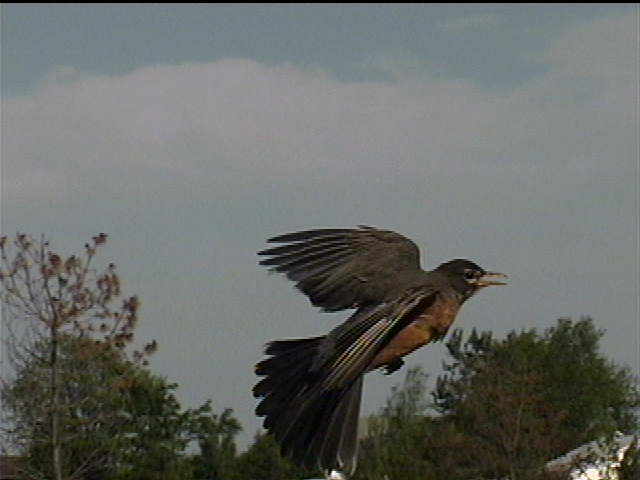
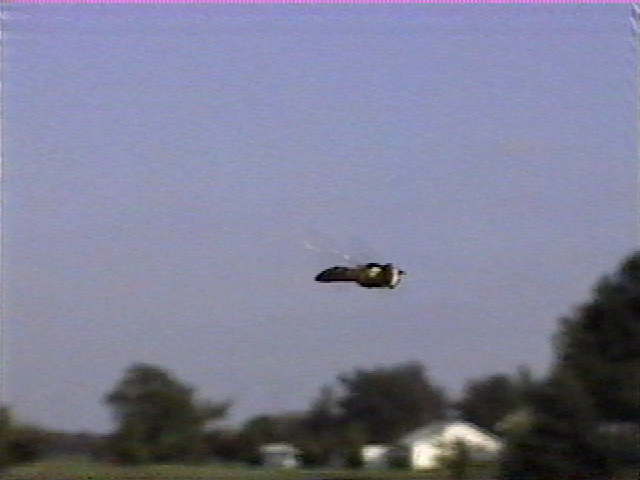
-
- Even closer is a bee flying a few inches from lens.
- We believe the Unidentified Flying Objects that appear
over the farm at a distance of approximately 265 yards or more are
genuine UFOs. George Ritter has always been open to have qualified experts
attempt to repeat his results with high speed film.
- Our goal is to promote research on UFOs and to discover
the true nature of the phenomenon, to educate the public, and to make breakthroughs
that could improve the life on our planet.
-
- Thank you again,
- Regards,
- George Filer
-
Hi George!
Thank you for submitting this material in defense of the images produced
by Mr. Ritter along with your personal information and detailed involvement
first hand in his case. My question now naturally would be, what are the
differences between the images you've submitted and the ones we commonly
see from Mr. Ritter (and others). There's no doubt, most video cams can
focus close up. Some have exceptional auto-focus and can zoom-to-focus
if a large enough object is detected close by (if set to do so). I notice
in the image of the passing bee (or is that a locust? Cicada?) that the
background is distinctly blurry. This shows that the video cam shifted
focus or was set for close up focus. We don't see that kind of background
in the pictures of 'UFOs' (BLURFOs in my view) above. Additionally, the
objects passing which become BLURFOs may be moving much faster and be farther
from the lens. If his camera is capable of something close to dual focus,
which it looks like it is judging from the bird shot, then our question
has to be centered on the camera settings for focus during the 'BLURFO'
shots.
-
- Naturally, my skeptical mind wants to know if the
bee hovered a bit, or approached at enough of an angle allowing the camera
a chance to detect it, and focus on it (and, in turn, render the background
blurry). Questions, questions, questions! When you note that the UFOs you
saw on the video were moving at thousands of miles and hour, judging from
their frame by frame advance, one can also suggest that the same effect
-- or rather illusion -- would be caused by a small, fast moving object
close to the camera, rather than a large, distant object. Because I think
we're really talking about a camera issue in the end.
-
- Perhaps in the future we can see some established
tests and experiments from Mr. Ritter. One I'd like to see if for George
to hang a large white sheet in the area where he usually shoots (toward
that silo) at roughly 100 feet from the camera, and instead of aiming the
camera at the sky, aim it at the sheet with whatever his traditional focal
setting is for UFO shots. My guess is very fast moving bugs and small birds
that fall somewhere in that non-focal range or which move by too quickly
for the cam to re-adjust focus, will make an appearance like tiny UFOs
in his other shots... streaks, blurred balls and discs, etc. The fact that
these objects are not being seen by a witness, but only produced through
a freeze frame process is what demands further experimentation.
Please feel free to submit any other material to this issue -- Mr. Ritter
also has that open invitation, of course. Let's keep the lines of communication
open. We have a lot to learn on ths one!
Side note: To Mr. Ritter's credit, I must say that he has captured on video
one of the most strikingly marvelous and rare images of ball lightning
I've ever seen. His diligence in continually shooting the skies around
his home is bound to turn up something given time. - Neff
-
-
-
- George Ritter Submits Images As His
Rebuttal. Click
Here
-
-
- Comment
From Bruce Cornet
2-20-4
- Dear George,
-
- How did you take these pictures? What type of equipment/camera
did you use? When were the pictures take? And where is the location of
these shots, and direction of the craft?
-
- These are all important pieces of information needed
in order to evaluate your work.
-
- Impressive if you can consistently duplicate your results.
My only question is why are these objects seemingly flying over the same
farm in the same direction? Did you track where they were going? Some seem
to be on a landing approach, while others seem to be taking off.
-
- Have you taken any college level courses in science?
-
- Yours truly,
- Bruce Cornet, Ph.D.
- Prof. Geology and Botany
- Raritan Valley Community College
- Somerville, NJ 08876
- wcornet@raritanval.edu
- http://www.monmouth.com/~bcornet
- bcornet@monmouth.com
-
-
-
- Comment
From Frank Warren
frank-warren@pacbell.net
2-22-4
-
- James,
-
- Kudos to you on the fine work you did in the article
titled "BLURFOS Are Not UFO'S" and the illustrations provided
therein. As modern technologies advance, and become more personable as
well as affordable, (e.g., digital cameras, etc.) providing "visual
evidence" of UAP (Unidentified Aerial Phenomenon) will, and has become
more widespread. Obviously, the argument against UAP becomes "less
static" when there is "supportive visual evidence" to such
events.
-
- All that said, as with any increased use with a relatively
new technology it's not surprising, if not expected, that there will be
a "new learning curve" to said technologies--your article in
my view is certainly evidence of that; speaking of evidence, it's important
to note, that with any UAP investigation, "photographic evidence,"
and in this instance, such that is "captured digitally" is only
"part of evidentiary picture." (No pun intended). "Digital
photographic evidence" becomes more substantial when there is "corroborating
evidence" in support thereof. In fact, it could be argued, that "lack
of supporting evidence" is "evidence itself" that the "digital
photographic evidence" might be imperfect. (E.g., no eye witnesses
to an event, when one or more witnesses were present).
-
- As you have shown in you article, as well as other researchers,
that "digital photography" or rather "our perception"
of what is captured digitally, can be completely the opposite of what we
believe them to be, it becomes paramount that time be taken to "eliminate"
all possibilities of what an object might be, that is captured digitally,
particularly when there is no corroborating evidence.
-
- In the end a "digital camera" is a tool that
"captures data" and as you so ardently pointed out "that
data" has a wide ranging interpretation of origin, therefore; the
importance lies within the "procedure of the analysis" of the
data. Without "supporting evidence" and unless all "known
objects" can be eliminated, in regards to a UAP investigation, the
virtue of the "digital photograph" is moot.
-
- With Warmest Regards,
Frank Warren
-
-
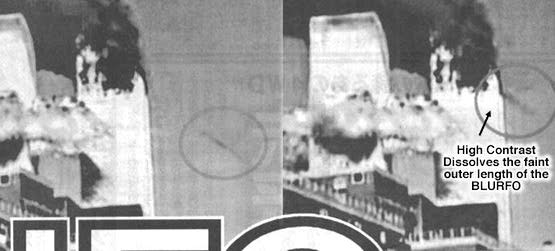
-
- Another possible example of a BLURFO. Right after
911 there were quite a number of video tapes believed by many to have captured
UFOs around the towers at the time of their destruction, though most appeared
to have a more earthly explanation - distant helicopters,
- classic BLURFO bugs, even ash swept across the
field of view and freeze framed in highly distorted fashion.
|


